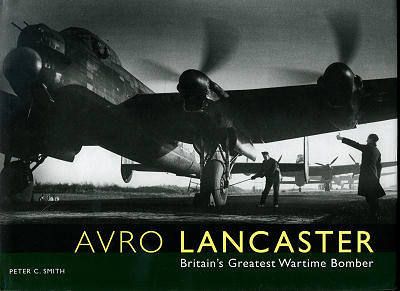 As the
B-17 is probably the most recognizable WWII bomber to most Americans, so it was with the
Lancaster and the British. This large British bomber was the result of several
interesting aspects of the way the RAF wanted to wage war as well as a bit of
serendipity and some politicking.
As the
B-17 is probably the most recognizable WWII bomber to most Americans, so it was with the
Lancaster and the British. This large British bomber was the result of several
interesting aspects of the way the RAF wanted to wage war as well as a bit of
serendipity and some politicking.
British military thinking of the 1930s was that the bomber
alone should be enough to cow the enemy into submission by destroying all of
that country's manufacturing and infrastructure. To that means, just about all
the monies spent on the RAF went into bombers. The truth was soon to be told
when the war got underway and large scale bombing raids resulted in a massive
loss of aircraft. Even the new bombers that were entering production were not
able to handle daylight bombing without large losses so the switch to area
bombing and night missions was made.
One of the new bombers entering the fray was the Manchester.
A plane with great potential, but horrible engines, the Rolls Royce Vulture.
This was the result of mating two V-12s to a single crankshaft. As so often
happened in cases where this was done, the resulting engine was not up to snuff
and nearly ruined was was otherwise a fine airframe. Politicking resulted in the
same basic airframe being used, but having four distinct Merlin engines vice the
coupled Vulture. The airframe was stretched and the result was the superb
Lancaster bomber.
Peter C. Smith is a highly regarded aviation author and takes
us through the history of the Lancaster and tells us something about the men who
flew it. Like the earlier Vulcan book, this one is in landscape format, so that
it can provide its photographs on a single page instead of crossing the dreaded
chasm that lurks at the center of every book.
In the book we learn just how adaptable the Lancaster was not
only to regular bombing, but to special missions. Thanks to its long, continuous
bomb bay, it was able to handle weapons that other bombers could not. Thinks
like the large depth charges used in the famous "Dam Buster" raids, or the
ability to carry the 10,000 lb Tallboy bombs used to capsize the Tirpitz or the
even more massive 22,000 lb Grand Slam bombs.
Of course, with the end of the war, production ceased and
with nuclear weapons now part of the standard arsenal, the need for a lot of
bombers went away. Still, the Lancaster was such a good airframe that it was the
bases for follow-on aircraft such as the Lincoln and the Shackleton; the latter
aircraft operating into the late 1980s. The book also includes a full rundown on
extant airframes; from those able to take to the air to those that are just
hulks, but have possibilities.
In all it is a superb book with tons of great photos, some of
them in color, and one that you
really should consider for your next purchase.
February 2009
Review book courtesy of
Specialty Press
 ,
where you can order your copy of this and many other superb aviation and
modeling books. Visit their website at the link above or call them at
1-800-895-4585
,
where you can order your copy of this and many other superb aviation and
modeling books. Visit their website at the link above or call them at
1-800-895-4585
If you would like your product reviewed fairly and quickly, please contact
me or see other details in the Note to
Contributors.
 As the
B-17 is probably the most recognizable WWII bomber to most Americans, so it was with the
Lancaster and the British. This large British bomber was the result of several
interesting aspects of the way the RAF wanted to wage war as well as a bit of
serendipity and some politicking.
As the
B-17 is probably the most recognizable WWII bomber to most Americans, so it was with the
Lancaster and the British. This large British bomber was the result of several
interesting aspects of the way the RAF wanted to wage war as well as a bit of
serendipity and some politicking.